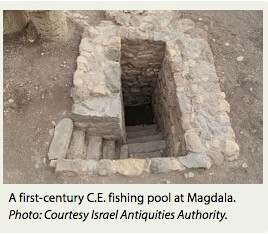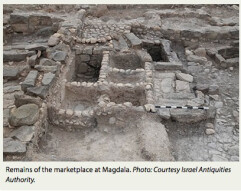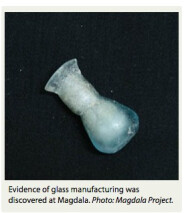The Fishy Secret to Ancient Magdala’s Economic Growth
Cornering the salted fish market
Excavations and research conducted around the Sea of Galilee  have revealed a great deal about the history of the Galilean towns and their populations during the first century C.E. At Magdala, hometown of Mary Magdalene in the Bible, excavations have uncovered a large marketplace with 28 shops, about 300 fishing weights, 40 pools and more than 4,000 ancient coins, the majority of which were minted in Jerusalem. Putting all of this together, the finds point to large-scale commercial interactions between Magdala and many other ancient cities, not only in Galilee but also in Jerusalem and other ports along the Mediterranean Sea, such as Caesarea Maritima.
have revealed a great deal about the history of the Galilean towns and their populations during the first century C.E. At Magdala, hometown of Mary Magdalene in the Bible, excavations have uncovered a large marketplace with 28 shops, about 300 fishing weights, 40 pools and more than 4,000 ancient coins, the majority of which were minted in Jerusalem. Putting all of this together, the finds point to large-scale commercial interactions between Magdala and many other ancient cities, not only in Galilee but also in Jerusalem and other ports along the Mediterranean Sea, such as Caesarea Maritima.
Historical sources such as Flavius Josephus, Cicero, Suetonius and Strabo say that the export of salted fish was so successful that Magdala (also known as Taricheae) soon became a self-sustaining town. Strabo, in particular, commends the excellent fish from Taricheae, which was available and highly esteemed in the Roman markets.1 The name Tarichos (“salted fish”) became the city’s international “brand,” since pickled fish was sold to Rome.
In 2010, my colleague, Dr. Luis Barba from the UNAM (National Autonomous University of Mexico), who works in collaboration with the Anahuac University of Mexico on scientific research and techniques at Magdala, made a geophysical exploration along our property (30,000 square meters). A digital map of the site revealed structures and streets beneath the soil and dirt. So far, we can see that there are six streets and six structures in addition to the ones we excavated.
The Galilee is one of the most evocative locales in the New Testament—the area where Jesus was raised and where many of the Apostles came from. Our free eBook The Galilee Jesus Knew focuses on several aspects of Galilee: how Jewish the area was in Jesus’ time, the ports and the fishing industry that were so central to the region, and several sites where Jesus likely stayed and preached.
The port of Magdala is 700 meters long, of which 500 meters have been uncovered, and could easily harbor many boats in antiquity. There were many other ports along the Sea of Galilee, but at Magdala the townspeople could develop the salted fish industry. Geographically, Magdala sits at the junction of an important Roman road that led from the Lower Galilee to Damascus. After the foundation of Tiberias in 19 C.E., the city could have established a favorable trading relationship with Magdala and the Romans along the road to Jerusalem, as well.

Dr. Ruth Jackson, a specialist in ancient glass and an advisor to Magdala regarding glass materials found here, says that the ancient town may also have produced glass vessels. We found evidence of glass manufacturing, such as waste glass materials, more than 1,800 glass pieces (some complete and many others to be restored) and glass sticks. Glass production was supported by mobile ovens (small basin-like or bowl-like structures), which were placed underneath the surface of the ground. Practically, these could be moved anywhere the craftsmen needed.
Another historical source writes about metal fabrication at Magdala. So far, we have found waste metal, but no other evidence of a metal workshop.
 Magdala’s income sources could allow the residents to afford expensive and well-constructed buildings, such as the first-century C.E. synagogue and Jewish ritual baths discovered in excavations. Magdala is the only town in Galilee, so far, that has found a first-century synagogue with frescoes, mosaics and a unique Second Temple model carved in stone. It is the first time that a stone like this has been discovered in the Biblical lands. The Jewish ritual baths we found are dated to the first century C.E. and are fed by underground water.
Magdala’s income sources could allow the residents to afford expensive and well-constructed buildings, such as the first-century C.E. synagogue and Jewish ritual baths discovered in excavations. Magdala is the only town in Galilee, so far, that has found a first-century synagogue with frescoes, mosaics and a unique Second Temple model carved in stone. It is the first time that a stone like this has been discovered in the Biblical lands. The Jewish ritual baths we found are dated to the first century C.E. and are fed by underground water.
The marketplace, fishing pools, fishing weights, port and glass materials demonstrate that Magdala was a significant place for trade. Its geographic location gave it advantage over other Galilean towns, such as Capernaum, Korazin and Bethsaida. Along with its synagogue and Jewish ritual baths, Magdala’s material remains testify to a community who placed a high value on its Jewish traditions as well as its economic wealth.
Bible History Daily - written by: Marcela Zapata-Meza • 08/09/2016
